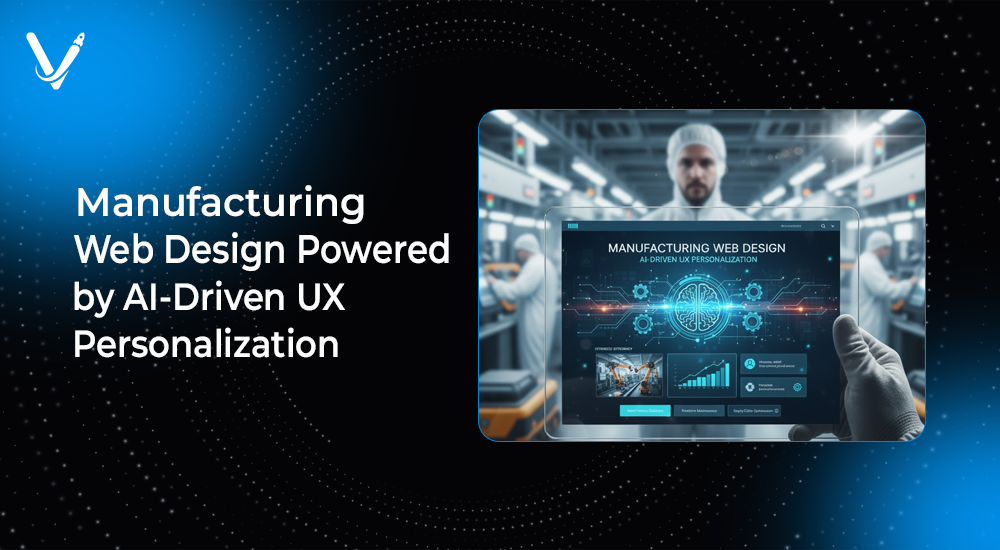Manufacturing Web Design Powered by AI-Driven UX Personalization


- Oct 16, 2025



Key Takeaways
The manufacturing industry has traditionally thrived on precision, efficiency, and scalability. But as markets shift to digital-first engagement, manufacturers are realizing that their websites are no longer static catalogs—they are intelligent sales tools. Modern customers, distributors, and partners expect seamless navigation, relevant content, and a user experience that feels personalized. This is where AI-driven UX personalization reshapes manufacturing web design.
Today, AI has moved beyond automation; it’s now the engine behind adaptive, user-focused web experiences. Imagine a manufacturing website that tailors its content, layout, and recommendations based on who’s visiting—a procurement manager, a field technician, or a potential investor. AI can make that happen in real time.
This article explores how AI-driven UX personalization transforms manufacturing websites into smart platforms that not only showcase products but also anticipate user intent, streamline interactions, and elevate conversion potential. We’ll break down how AI enhances design, boosts engagement, and creates lasting value for manufacturing enterprises ready to embrace the digital future.
Manufacturing companies often lag behind consumer-focused industries when it comes to web design innovation. Many industrial websites still rely on outdated templates, static visuals, and generalized product information. Yet the B2B buyers interacting with these sites have evolved—they expect the same level of personalization and usability they experience in eCommerce platforms.
Buyers now conduct deep research online before contacting sales teams. They want to explore technical specifications, compare models, view real-world use cases, and interact through self-service portals. Traditional designs fail to cater to this behavior.
Here’s the challenge: manufacturers must create digital experiences that mirror the sophistication of their products. They need web ecosystems that personalize interactions based on user roles, industry segments, and purchase intent. And this transformation starts with AI-driven UX design—a fusion of intelligent analytics, adaptive content, and human-centered design principles.
AI-driven UX personalization means using algorithms, behavioral insights, and predictive models to adapt digital experiences in real time. It’s about creating an interface that learns from each visitor’s interaction—what they click, search, and prefer—and then adjusts design elements accordingly.
In manufacturing, where products are complex and customer journeys vary widely, AI becomes the bridge between raw data and meaningful engagement. It converts website analytics into actionable intelligence that refines layout, messaging, and visual hierarchy for each type of visitor.
AI doesn’t replace creativity—it enhances it. Designers can use AI to automate tedious tasks like heatmap analysis, A/B testing, and content placement optimization, allowing them to focus on strategic improvements.
AI’s biggest advantage lies in its ability to process vast amounts of behavioral and contextual data. For instance:
By merging behavioral analytics with machine learning, manufacturing companies can create web experiences that feel deeply human—while being powered by technology.
AI tools can predict what a visitor will do next based on browsing patterns. For example, if a returning visitor frequently explores CNC machining tools, the homepage can automatically highlight the latest CNC innovations or offer a personalized quote feature.
Predictive behavior modeling ensures the site feels intuitive—anticipating needs instead of reacting to them. This proactive personalization can dramatically increase engagement rates, product inquiries, and lead conversions.
Gone are the days of one-size-fits-all web content. AI algorithms enable dynamic content delivery, meaning the website changes in real time based on who’s viewing it.
For example:
Dynamic personalization ensures every user gets exactly what they need without unnecessary clicks, reducing friction in the user journey.
Chatbots powered by AI have become indispensable for manufacturing websites. These aren’t simple scripted bots—they use natural language processing (NLP) to understand complex queries related to machinery, spare parts, specifications, or order tracking.
AI chatbots can:
By integrating with CRM and ERP systems, chatbots also serve as data collectors—capturing insights about user intent that can be fed back into UX optimization loops.
Manufacturing websites often feature thousands of products, models, or components. AI-powered search functions make this complexity manageable. These systems use semantic search, meaning they understand intent rather than just keywords.
For instance, a user typing “lightweight aluminum valves for high pressure” receives highly relevant suggestions—filtered by material, capacity, and certification. The system learns over time which filters and keywords drive conversions, continuously improving accuracy.
AI analyzes which CTAs resonate with different visitor groups. A purchasing manager might respond better to “Request a Quote,” while an engineer might engage with “Download Specifications.” The AI engine dynamically adjusts CTAs, colors, or positioning to match visitor profiles.
This data-driven customization turns ordinary web pages into powerful lead-generation machines—tailored for every interaction stage.
AI systems can modify website layouts to emphasize sections that each user finds valuable. For example:
This adaptive interface ensures maximum relevance without overwhelming users with information.
AI-driven sentiment analysis tools can monitor user interactions—tracking engagement patterns, feedback, or chat logs to detect frustration or satisfaction. This helps designers identify weak UX areas and optimize them instantly.
For example, if users frequently abandon a form midway, AI can suggest simplifying fields or adding a progress bar. Over time, these insights create a smoother, frictionless experience.
AI-powered tools like Adobe Sensei and Uizard analyze visual patterns and suggest improvements in color balance, contrast, and accessibility. In manufacturing, where clarity and precision matter, this ensures the interface aligns with brand identity and usability standards.
Additionally, AI can generate visual prototypes or layout variants, enabling designers to A/B test multiple designs rapidly without manual rework.
Traditional web design relies heavily on intuition and subjective creativity. AI introduces data-driven design—a fusion of analytics and aesthetics. This synergy ensures that every design decision aligns with measurable outcomes like engagement, dwell time, and conversion rates.
For manufacturing firms, this is crucial. Their websites often serve as the first interaction point for global clients. When design decisions are backed by user data, the brand communicates not just professionalism but technological leadership.
AI bridges the creative and analytical divide—allowing teams to move from guesswork to precision design. This continuous optimization cycle keeps manufacturing sites agile in evolving digital landscapes.
AI ensures that visitors interact with relevant content at every touchpoint. This reduces bounce rates and encourages deeper exploration—turning visitors into qualified leads.
B2B manufacturing purchases are typically complex. AI streamlines information delivery, ensuring decision-makers find essential details quickly, thus accelerating purchase timelines.
With predictive recommendations and personalized CTAs, manufacturers witness higher form submissions, quote requests, and sales inquiries.
AI personalizes post-purchase interactions too—recommending complementary products, sending automated maintenance reminders, or offering support portals.
For manufacturers operating in multiple regions, AI simplifies localization—translating and adapting UX elements for cultural and linguistic nuances automatically.
AI can differentiate between corporate buyers, suppliers, and technical teams—creating role-specific journeys. For instance, engineers can access configuration tools, while executives see cost-benefit analyses.
Manufacturers often share product manuals, CAD files, and videos. AI organizes these assets dynamically based on visitor roles or frequently downloaded files, ensuring easy access and improved knowledge sharing.
AI algorithms score leads based on interaction data—identifying which prospects are most likely to convert. This enables marketing teams to prioritize high-value opportunities efficiently.
Modern AI tools integrate seamlessly with enterprise platforms. This ensures customer data synchronization, unified analytics, and smarter follow-up strategies.
A heavy-equipment manufacturer integrated AI-based personalization on its product portal. Visitors were segmented into engineers, buyers, and maintenance teams. Each group saw tailored navigation and resources. Result: a 40% increase in quote submissions and a 25% drop in bounce rates.
Using predictive analytics, the supplier’s website started displaying region-based product catalogs and logistic options. Visitors from Europe saw CE-certified product lines and regional distributors. This led to a 30% growth in international leads within months.
AI chatbots handled over 60% of customer interactions—answering FAQs, providing part compatibility data, and scheduling demos. The brand reduced support costs by 45% while improving satisfaction scores.
Building an AI-powered manufacturing website isn’t a one-time task—it’s an iterative journey involving continuous learning and refinement.
The process starts with identifying audience segments, user intents, and business objectives. Website analytics, CRM insights, and customer feedback become the foundation for training AI models.
Designers use AI-assisted prototyping tools to visualize dynamic layouts. Machine learning helps test user flows and optimize wireframes based on behavioral predictions.
Developers integrate AI APIs—such as recommendation engines, chatbots, or personalization systems—into CMS platforms. These can be custom-built or connected through cloud AI services like Google Vertex AI or Azure Cognitive Services.
Continuous A/B testing backed by AI ensures the website evolves based on live data. Adaptive algorithms keep learning to refine UX decisions.
As product catalogs and markets evolve, AI models are retrained to ensure relevance, accuracy, and scalability across all user segments.
AI brings precision, but human designers provide empathy. Combining both ensures the website remains efficient yet emotionally engaging.
With AI collecting behavioral data, compliance with GDPR and similar laws is essential. Manufacturers must maintain transparency in how user data is stored and processed.
Industrial buyers often research on mobile devices. AI should adapt layouts responsively and ensure consistent cross-device experiences.
Use computer vision tools to analyze product images, detect quality inconsistencies, or recommend similar items visually. It enhances engagement for technical buyers.
AI-driven voice assistants and visual search can help users quickly locate technical documentation or compatible parts using natural language or image recognition.
As Industry 5.0 gains momentum, the boundaries between human creativity and AI precision will blur further. Future manufacturing websites will not just personalize—they will predict, converse, and collaborate.
Imagine a platform where:
The convergence of AI, IoT, and digital twins will redefine manufacturing UX—turning websites into intelligent hubs connecting humans, machines, and data.
AI-driven UX personalization is no longer a luxury—it’s a necessity for manufacturers aiming to thrive in a competitive digital economy. A well-designed, AI-powered website acts as a silent yet powerful salesperson—one that understands the visitor, anticipates their needs, and delivers experiences that convert.
For manufacturers, this transformation means moving beyond static designs and embracing adaptive intelligence. It’s about crafting digital ecosystems that are as smart, precise, and efficient as the machinery they build.
At Vasundhara Infotech, we specialize in creating AI-powered manufacturing web solutions that blend creativity with technology. Our team builds dynamic, personalized platforms designed to engage, convert, and scale seamlessly. Let’s craft a website that reflects your manufacturing excellence—powered by the intelligence of AI.
Let’s build the future of digital manufacturing together. Contact us today to discuss your project.
Copyright © 2025 Vasundhara Infotech. All Rights Reserved.